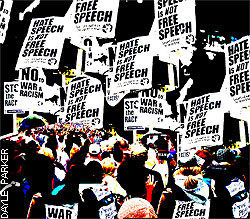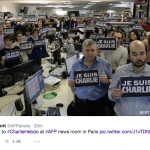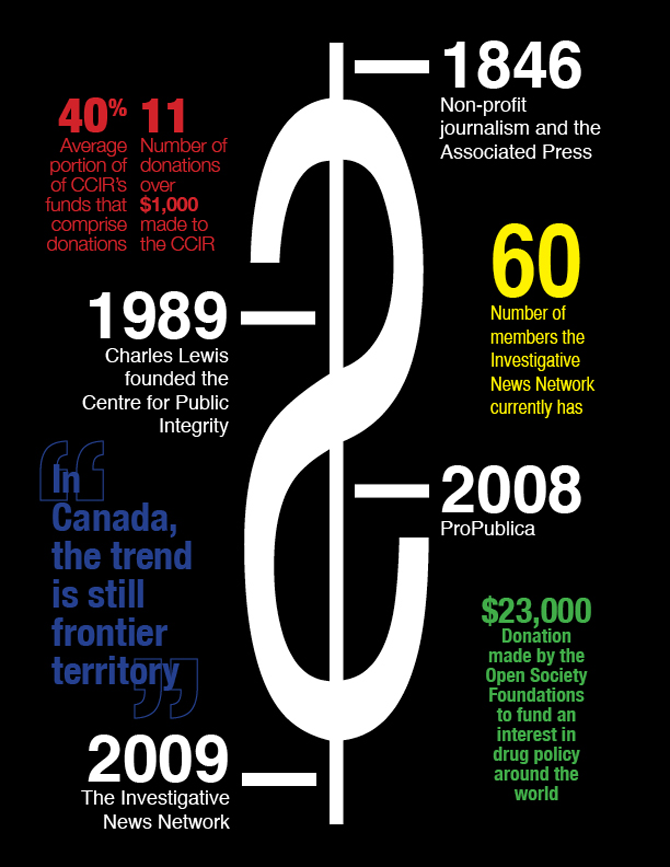Fear of Publishing
Fallout from Muslim reaction to Jyllands-Posten caricatures of the Prophet Mohammed has led to contentious debate in Canada on what constitutes freedom of speech in the West
When cartoons ignite worldwide protests, resulting in torched embassies and many deaths, the decision to reprint is easy. Many outlets believe in freedom of speech and providing readers with context, but few in Canada have actually run the cartoons. Western Standard magazine and The Jewish Free Press, both based in Calgary, are two that did, and they’ve both been slapped with human rights complaints.
The decision not to publish the dozen caricatures of the Prophet Mohammed, which first appeared in Denmark’s Jyllands-Posten newspaper last September, has become almost a no-brainer for Canadian media owners. They simply say they’re respecting religious sentiments. But a Compas, Inc. poll conducted February 20 found that many working journalists believe fear is the real reason more Canadian outlets haven’t reprinted the satirical works. According to the survey of 221 Canadian journalists, seven out of ten think more media should have carried the caricatures. And seventy-eight per cent of those journalists think fear was why Canadian media executives held back.
Here’s a synopsis of the controversy so far. Jyllands-Postencommissions twelve satirical images of Mohammed, the representation of whose likeness is forbidden in Islam, by twelve separate cartoonists. One infamously depicts Mohammed with a bomb in his turban. Innocuous caricatures are also included, like one of a schoolboy-aged Mohammed scribbling on a blackboard: “The journalists atJyllands-Posten are a bunch of reactionaries.”
In “Why I published the cartoons,” the Jyllands-Postenculture editor Flemming Rose explains the cartoons are a response to “incidents of self-censorship in Europe caused by widening fears of intimidation in dealing with issues related to Islam.” He suggests the fiasco may serve as a quasi-integrationist tactic to accept Muslims, like others, as subjects of traditional Danish satire.
In his defence of freedom of speech, Rose cites the totalitarian climate of the Cold War as a lesson against the proverbial “slippery slope” of giving into demands for censorship.
In one case of giving in, the editorial staff at the New York Press, an alternative weekly, walks out following their publisher’s change of heart, pulling the caricatures at the eleventh hour.
In another, the editor of France-Soir is fired after publishing cartoons of several religious deities under the caption: “Yes, we have the right to caricature God.”
Ezra Levant, publisher of the Western Standard, certainly would concur. He defends his decision to reprint the cartoons in a debate with Scott Anderson, the Ottawa Citizen‘s editor-in-chief and vice-president of editorial for CanWest’s newspaper chain, on CBC Radio’s The Current.
“One thing we don’t do as responsible journalists is offend for the sake of offending,” Anderson argues.
There are many Arabs and Muslims in Ottawa, Levant contends, implying this might have been in the back of Citizen editors’ minds, adding: “This newfound respect for religion is code word for ‘I’m afraid.'”
In the final minutes, Anderson denies deference to religion played any part in his decision, but admits the hostile response did. “Under different circumstances we may have published these cartoons to illustrate the story,” he explains, “but the reaction is so vitriolic and so angry.”
Levant confesses he’s “a little bit” intimidated – but “not so scared that I’m going to throw out freedom of speech” – and hires extra security for the Standard‘s offices.
Security may lie behind the hesitation to print, according to Jonathan Kay, managing editor of comment at the National Post. “It is expensive and difficult to provide security for an office building and printing presses,” he says. “I think this was a bigger factor than most media outlets were willing to admit.”
So far, Levant has received 7,000 emails and 2,000 calls, but no one’s shown up at the Standard‘s Calgary offices.
Doug Firby, who edits the editorial page at the Calgary Herald, thinks Levant is playing to his perceived right-wing readership. “I don’t believe, as he alleges, that he was motivated by any desire to defend freedom of expression,” says Firby. “I thought it was irresponsible and a bit childish.”
At The Globe and Mail offices in Toronto, the debate over running the cartoons is first raised at a morning news meeting by Marcus Gee, editorial pages editor. Gee argues in favour of publishing, but the final decision against is made by editor-in-chief Edward Greenspon. In his editorial, “Self-censorship vs. editing,” he labels the cartoons “unnecessarily provocative.” It’s a phrase Giles Gherson, The Toronto Star‘s editor-in-chief, uses in his own editorial on the subject.
Respectfully disagreeing with his boss, Gee says, “My own feeling was we should have published them. Canadian newspapers are pretty strong on freedom of expression. They made an exception in this case, and you can argue whether we should’ve made that exception.”
Gee thinks a newspaper should supply the readers with context. “What is this all about? How did it all start?” he asks. “You can’t really understand that properly unless you’ve seen the images.”
The Globe offers readers context in other ways. Lengthy pieces delve into the history of Islam and the Prophet himself. Greenspon calls this “the spirit of illumination over heat.”
Doug Saunders, the Globe‘s foreign correspondent, also takes part in the dialogue. He writes about Muslim identity in Europe and answers readers’ questions through an online question-and-answer session. “I suspect that most major newspapers, including this one, would print them if they were in any way hard to obtain,” he argues. “But since they’re so widely available, why should everyone automatically print them?”
CBC News: Morning‘s international editor Harry Forestell points out this same fact in an interview with Levant, who later laughs it off, retorting, “If the best argument that CBC can muster is that some little blogger is already meeting Canada’s demand for news, then what’s the point of the CBC?”
But if Canadian media are shielding readers from the offending images, many of the rioters haven’t seen them either. In Saunders’s online Q&A, he notes this fact. He says the bulk of protestors have acted on hearsay, along with the belief that major English papers have reprinted the cartoons.
Saunders also speaks with Ahmed Akkari, the Islamic scholar who distributed a booklet of the cartoons, along with other obscene caricatures of the Prophet as a pig, a dog and a sodomite (caricatures that were never published in Jyllands-Posten). Akkari wished to call on fellow Muslims for support, but later regretted the outcome. “I suspect he was partly naïve,” writes Saunders, “but also somewhat disingenuous – obviously, the package was intended as a provocation of some sort.”
The ongoing uproar has provoked some dialogue, which is likely the most positive thing it’s spawned. “Both sides certainly know a lot more about each other than they did two weeks ago,” writes Haroon Siddiqui, theStar‘s editorial page editor.
Siddiqui points to a lack of understanding of Islam in the West, which consists largely of Judeo-Christian societies. Robert Fisk, The Independent‘s Middle East correspondent, writes, “The fact is that Muslims live their religion. We do not.”
Tensions run high in the Middle East, where fear of the West encroaching on Muslim land and culture cannot be dismissed easily. The actions of the United States and its coalition partners in Iraq and Afghanistan, rightly or wrongly, are prime examples of fuelling this fear.
Siddiqui asserts that Islamophobia has played a big part in the Jyllands-Posten episode. He characterizes the paper as freely anti-Muslim. Danish Muslims no doubt have at times faced xenophobia within their own country – one member of the right-wing Danish People’s Party has posted comments online likening Muslims to “cancer cells.”
In Canada, Kim Bolan has dealt with religious sensitivities for over two decades as a reporter for theVancouver Sun. Although she admits she’s relatively uninformed about the entire crisis, she says, “My gut response is that most Canadian media outlets don’t want to deal with the underlying issues or even assess the concerns of protestors. Nor do they appreciate the range of debate within the Muslim community because our approach to minorities is often very one-dimensional.”
Then Bolan adds this ominous caveat: “I do think most newspapers will adopt some self-censorship in the future without even thinking about the real issues, because they don’t want the hassle.”
by Marlene Rego
Marlene Rego was the Associate Editor for the Summer 2006 issue of the Ryerson Review of Journalism.














































